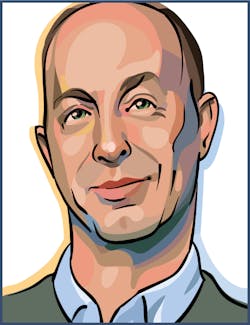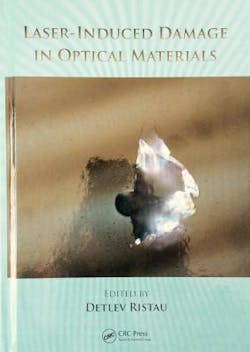
For science and industry, the laser has many advantages over other light sources -- including narrow linewidth (resulting in high temporal coherence), high wall-plug efficiency, high spatial coherence (high beam quality), and the ability to deliver very high powers (continuous-wave) or energies (pulsed). One of the great achievements of the laser industry has been to develop high-power and high-energy lasers that maintain excellent beam quality.
These characteristics give lasers the ability to deliver incredibly high intensities or energy doses; as a result, lasers can easily cause damage to the very optics that focus or otherwise channel the laser light. Two approaches can lessen this problem: system design for reduced intensity on optics, and development of more-damage-resistant optical materials and coatings.
A new book brings together top-level experts in the field of optics laser damage to provide background, extensive measurements of laser-induced damage (LID) to various materials, surfaces, and thin films, and descriptions of R&D efforts to increase damage resistance. The book is Laser-Induced Damage in Optical Materials, edited by Detlev Ristau, 2015 CRC Press/Taylor and Francis Group, ISBN 978-1-4398-7216-1. This book, which is divided into four sections (see below), should be of interest to anyone working in the LID field, as well as those who are developing very-high-energy and power laser systems.
Fundamentals
M. J. Soileau, the founding director of CREOL, The College of Optics and Photonics at the University of Central Florida, provides a historical overview of the field, describing the growing knowledge of LID in the first years after the invention of the laser. The fundamentals of LID by thermal effects, defect-induced damage, self-focusing and nonlinear effects, and femtosecond LID are then given by various authors.
For example, the ultrafast LID section, written by Luke Emmert and Wolfgang Rudolph, both of the University of New Mexico, presents both detailed modeling and test results, including for single-pulse and multiple-pulse damage, the latter including the special case of two pulses with various spacings. They note that LID thresholds (LIDTs) are likely controlled by the accumulation of LID over timescales ranging from hundreds of femtoseconds to seconds and longer. A great reduction in multipulse LIDT in vacuum shows the likely influence of oxygen diffusion on defect formation.
Measurements
Noted researchers give details on measurement and detection of laser-induced damage (Jianda Shao of the Shanghai Institute of Optics and Fine Mechanics), the statistics of LIDT measurements (Jonathan Arenberg of Northrop Grumman Space Technology), and the measurement of light scattering, transmittance, and reflectance (Sven Schröder and Angela Duparré of the Fraunhofer Institute of Applied Optics and Fine Mechanics).
In one example, Shao gives an overview of LID detection techniques, including microscopy, scattered-light diagnostics, and the use of a plasma-spark monitor. He defines LIDT and delves into the measurement of single-shot, multishot, ramp, and raster-scan tests, describing an example LID laser test system. He also defines functional damage threshold (FDT), the minimum laser energy or power density at which a damaged optic degrades the performance of a system.
Materials, surfaces, thin films, and contamination
This largest book section delves into info and test results on quartz and glasses, crystalline materials for UV applications, materials for lasers (frequency conversion, Q-switching), surface manufacturing and treatment, into on optical coatings and thin-film production, high-power coatings for near-IR lasers, coatings for femtosecond lasers, and spaceborne applications.
Laurent Lamaignère of Commisariat à L’Energie Atomique (CEA) discusses intrinsic and defects-related bulk damage, wavelenth dependance, and pulse duration on LID of glass, along with detailed info on surface damage, including damage initiation and growth as a function of laser-beam characteristics and other conditions, including nonlinear effects. Angus Macleod of the Thin Film Center discusses the fundamentals of thin-film coatings and essential related info such as laser coherence and effects of the substrate material. Christopher Stolz of Lawrence Livermore National Laboratory discusses the very important subtopic of near-IR high-power coatings, including LID due to electromagnetic field and plasmas, and damage mitigation techniques. Substrate cleaning, filtration, arc suppression, defect smoothing, and other techniques can also reduce LID. His discussion on antireflection (AR) coatings includes hard dielectrics, sol-gel coatings, and AR surface microsctructures.
Applications
Three example applications are covered in the final section: lithography in the deep ultraviolet (DUV) and extreme ultraviolet (EUV) by Klaus Mann of Laser Laboratorium Göttingen, free-electron lasers by Michelle Shinn of Thomas Jefferson National Accelerator Facility (which has its own free-electron laser), and the high-energy petawatt PHELIX laser and its optics by Stefan Borneis of GSI Helmholtzzentrum für Schwerionenforschung, PHELIX/PP. Germany’s largest laser installation, PHELIX is intended for heavy-ion and laser-heated dense-plasma experiments at focused-beam intensities of 1021 W/cm2. The system includes 315-mm-diameter Nd:glass disk amplifiers, a Faraday isolator, a second-harmonic-generation crystal, and other high-energy optics.
The development of LID-resistant optics has gone hand-in-hand with that of the laser itself. If you are interested only in the uses of a helium-neon laser, this book might not be for you -- but for many others, who are working on even medium-power or energy laser systems, your optics at certain points in the system may be vulnerable to LID. But, due to the efforts of researchers such as those presenting in Laser-Induced Damage in Optical Materials, the means to prevent such damage are ever-growing in their effectiveness.

John Wallace | Senior Technical Editor (1998-2022)
John Wallace was with Laser Focus World for nearly 25 years, retiring in late June 2022. He obtained a bachelor's degree in mechanical engineering and physics at Rutgers University and a master's in optical engineering at the University of Rochester. Before becoming an editor, John worked as an engineer at RCA, Exxon, Eastman Kodak, and GCA Corporation.
